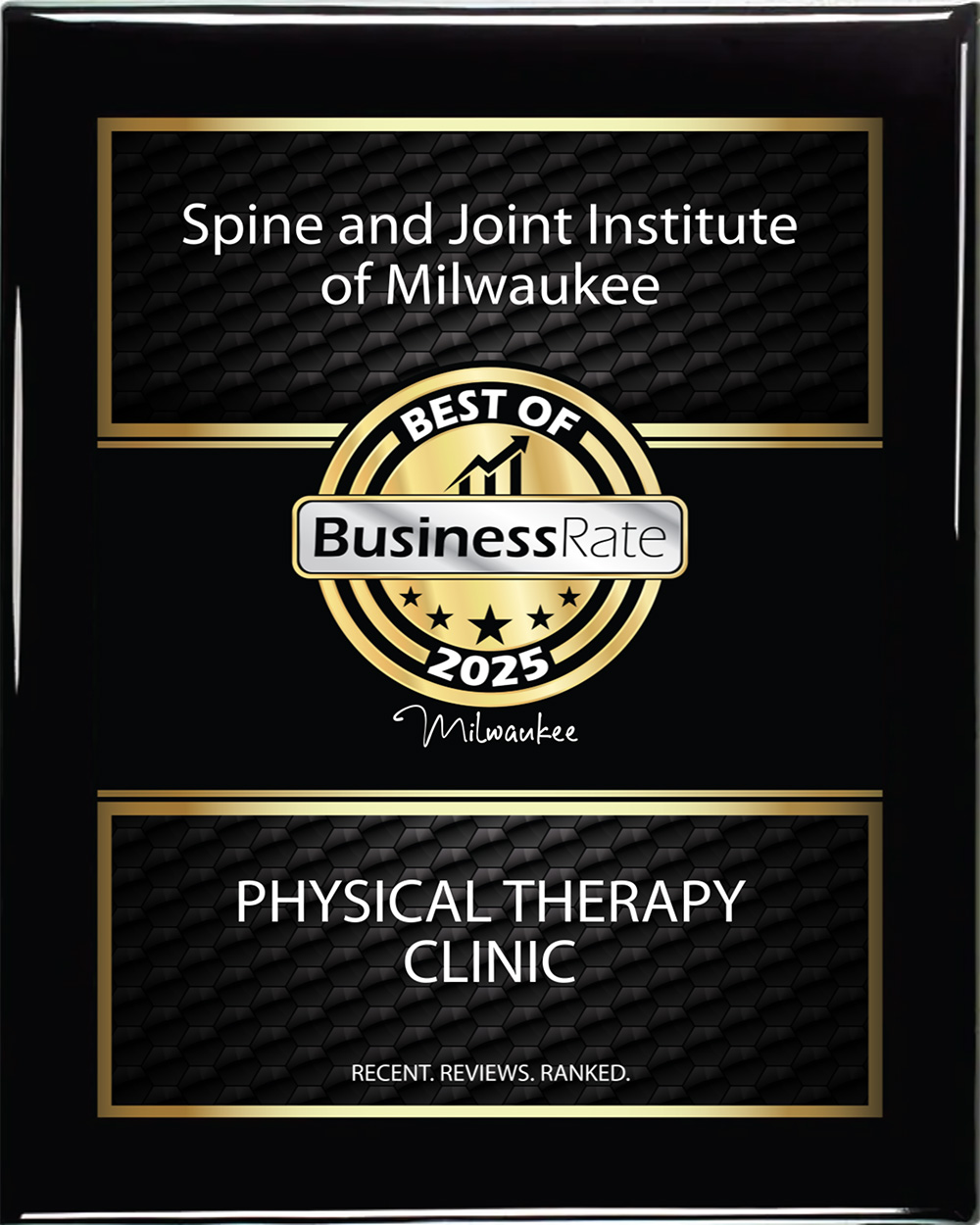The spine, also known as the backbone, is a column of bones, discs, joints, soft tissues, and nerves running from the head and down the back. The spinal cord sends signals from the brain to the rest of the body, allowing an individual to move freely and bend with flexibility. When someone suffers trauma to the spinal cord, it could lead to serious and life-altering consequences, often causing permanent changes in strength, feeling, and other body functions below the injury site.
Unfortunately, some workplaces have an increased risk of spinal cord injuries, and the best way to address it is through awareness and prevention. However, after an on-the-job spinal injury, they need comprehensive medical and rehabilitative care to put them on the path to recovery.
If you’ve suffered a spinal injury at work, you are not alone, and we are here to help. Spine and Joint Institute of Milwaukee's spinal cord injury specialists are ready to guide you through this difficult time and help you heal from your trauma as we help you through your workers’ compensation claims process. With our in-depth knowledge of workers’ compensation claims and the evidence required to obtain benefits, we know how to properly document your injury and treatment, building your case as you focus on recovery.
The two main types of spinal cord injuries are complete and incomplete injuries. These classifications help describe how much of the motor and sensory functions are affected. Additionally, injuries are often identified by the specific vertebrae involved.
Complete Spinal Cord Injury involves a total loss of sensation and motor function below the level of the injury. There is minimal to no function in the muscles and nerves below the injury site. The injured person may experience paralysis and loss of sensation on both sides of the body.
Incomplete Spinal Cord Injury means that there is some remaining function and sensation below the level of the injury. Incomplete injuries vary widely in terms of the degree of impairment. Some individuals may retain significant motor and sensory functions, while others may have limited function.

Thoracic and lumbar spine injuries refer to injuries in the spinal column's mid and lower sections. These injuries can have varying degrees of impact on motor and sensory functions, depending on the severity and specific location of the injury.
The thoracic spine is the middle portion of the spinal column, consisting of 12 vertebrae labeled T1 to T12. This region is located between the cervical (neck) and lumbar (lower back) sections of the spine. Thoracic spine injuries are less common than cervical or lumbar injuries due to the stability provided by the ribcage. Injuries to the thoracic spine can result in different levels of impairment, including paralysis and sensory loss, depending on the severity of the injury. These injuries may affect the trunk and lower extremities. Common thoracic spine injuries include fractures, dislocations, contusions, and compression fractures. Severe injuries may lead to paraplegia (paralysis of the lower extremities) or affect trunk function.
The lumbar spine is the lower part of the spinal column, consisting of five vertebrae labeled L1 to L5. It is located below the thoracic spine and above the sacral spine. Lumbar spine injuries are relatively common and can result from trauma, accidents, or degenerative conditions. Injuries to the lumbar spine can lead to various symptoms, including pain, numbness, tingling, and weakness in the lower back and legs. The severity of symptoms depends on factors such as the specific vertebrae involved and the extent of nerve damage. Common lumbar spine injuries include herniated discs, fractures, contusions, pinched nerves, sciatica, and spondylolisthesis. These injuries may cause difficulty walking, impaired bowel or bladder function, and other neurological deficits, depending on the severity.
It's important to note that both thoracic and lumbar spine injuries can range from mild to severe. The specific treatment and rehabilitation plan for individuals with these injuries will depend on the nature and extent of the injury, and it typically involves a specialized approach, including medical, surgical, and rehabilitative interventions. Early and appropriate medical care is crucial for the best possible outcomes for individuals with thoracic and lumbar spine injuries.
Working in construction poses several risks for spinal cord injuries due to the nature of the tasks involved, the use of heavy machinery, and the potential for falls or accidents. Here are some ways in which construction work can lead to spinal cord injuries:
Construction workers often work at elevated heights, such as on scaffolding, ladders, or rooftops. Falls from these heights can result in severe injuries, including spinal cord injuries.
Uneven surfaces, wet conditions, and debris on construction sites can contribute to slips and trips. A fall can lead to injuries, including spinal cord damage, especially if the worker lands on their back or neck.
Construction sites involve the use of tools, materials, and equipment that can fall from heights. If a worker is struck by a falling object, it can lead to serious injuries, including those affecting the spinal cord.
Workers involved in trenching and excavation work may be at risk of cave-ins or collapses. If a worker is trapped or struck by collapsing soil or materials, spinal cord injuries can occur.
Employees working in construction, manufacturing, or other industries may be at risk of being struck by tools, equipment, or other objects. A direct impact on the head can lead to a head injury like a concussion or traumatic brain injury.
Construction sites use various heavy machinery and equipment, such as cranes, forklifts, and bulldozers. Accidents involving these machines can cause traumatic injuries, including spinal cord injuries.
Lifting heavy objects or performing repetitive manual tasks without proper ergonomic practices can lead to overexertion injuries. These injuries may include strains or fractures that can impact the spine.
Construction sites often involve electrical work. Accidents such as electric shocks or electrocution can cause severe injuries, including damage to the spinal cord.
Malfunctions or misuse of tools and equipment can lead to accidents. A tool failure or malfunctioning equipment may result in injuries, including spinal cord injuries.
Failure to implement or adhere to proper safety measures, such as the use of personal protective equipment (PPE), safety barriers, and warning signs, can increase the risk of accidents that may result in spinal cord injuries.
To mitigate the risk of spinal cord injuries in the construction industry, employers implement safety protocols, provide appropriate training, use protective equipment, and adhere to occupational health and safety regulations. Regular inspections, hazard assessments, and a strong safety culture contribute to minimizing the potential for accidents and injuries on construction sites.


A herniated disc, also known as a slipped or ruptured disc, is a common spinal condition that occurs when the soft, gel-like center of a spinal disc protrudes through a tear or weakness in the disc's tough outer layer. Spinal discs are rubbery cushions between the vertebrae of the spine, acting as shock absorbers and providing flexibility to the spine.
When a disc herniates, the inner gel-like material (nucleus pulposus) can press against nearby nerves, leading to symptoms such as pain, numbness, or weakness in the affected area. The location of the herniated disc in the spine determines which nerves are affected and the specific symptoms experienced. Common causes of a herniated disc include:
Age-Related Degeneration. Over time, the discs in the spine naturally lose water content and become less flexible, making them more prone to herniation, especially in older adults.
Trauma or Injury. Sudden, forceful movements, or lifting heavy objects improperly can cause disc herniation, particularly if the spine is subjected to excessive pressure or twisting.
Repetitive Strain. Activities or occupations that involve repetitive lifting, bending, or twisting motions can increase the risk of disc herniation over time.
Genetic Factors. Some individuals may have a genetic predisposition to developing disc herniation due to factors such as disc shape or structural abnormalities in the spine.
Symptoms of a herniated disc can vary depending on the location and severity of the herniation. They may include:
Treatment for a herniated disc typically begins with conservative measures such as rest, physical therapy, pain medication, and anti-inflammatory drugs. In cases where conservative treatment fails to provide relief or if symptoms are severe, more invasive interventions such as epidural steroid injections or surgery may be considered to alleviate pressure on the affected nerves and relieve symptoms.
The financial implications of a spinal cord injury suffered at work can be significant and overwhelming, impacting many aspects of a victim’s life. Here are some of the costs of a spinal cord injury:
Medical Expenses. Spinal cord injuries often require extensive medical treatment, including emergency care, surgeries, hospitalization, rehabilitation, physical therapy, and additional ongoing medical care. The costs associated with these medical services can add up quickly, particularly if the injury results in long-term disability or complications.
Lost Income. A spinal cord injury may prevent an individual from returning to work temporarily or permanently, leading to a loss of income. Workers' compensation benefits may provide wage replacement to partially offset this loss, but the amount and duration of these benefits can vary depending on factors such as the severity of the injury and state laws.
Disability-Related Expenses. Individuals with spinal cord injuries may incur additional expenses related to their disability, such as the cost of mobility aids (wheelchairs, walkers), home modifications (ramps, bathroom modifications), assistive devices (adaptive technology), transportation (accessible vehicles), and personal care assistance.
Legal Costs. Resolving a workers' compensation claim or pursuing a lawsuit for a spinal cord injury can involve legal fees and expenses. Hiring an attorney to advocate for your rights and navigate the complex legal process may be necessary to ensure you receive the compensation you deserve. Many workers’ compensation lawyers work on a contingency fee basis, meaning you don’t pay unless you win your case.
Long-Term Care Costs. Spinal cord injuries often require ongoing care and support, which can be expensive. Long-term care facilities, home health aides, medical supplies, and medications can all contribute to the overall financial burden of the injury.
Psychological and Emotional Impact. The financial implications of a spinal cord injury extend beyond monetary expenses and can also include the psychological and emotional toll on the individual and their family. Coping with the challenges of a spinal cord injury, adjusting to a new way of life, and dealing with feelings of loss or grief can all impact financial well-being.
It's important for individuals who have suffered a spinal cord injury at work to explore all available resources for financial assistance, including workers' compensation benefits, Social Security Disability benefits, vocational rehabilitation services, and community support programs. Seeking guidance from financial advisors, legal professionals, and healthcare providers can also help navigate the financial challenges associated with a spinal cord injury.
Surgical treatment for spinal cord injuries aims to stabilize the spine, relieve pressure on the spinal cord, and address any associated complications. The specific surgical approach depends on the type and severity of the spinal cord injury. Here are some common surgical procedures:
It's important to note that the success of surgical treatment for spinal cord injuries depends on various factors, including the severity of the injury, the overall health of the individual, and the presence of any complications. The decision to undergo surgery and the specific surgical approach should be carefully considered in consultation with a medical team specializing in spinal cord injury management.

Workers' compensation can provide several forms of assistance after a spinal cord injury is sustained at work:
Medical Expenses Coverage. Workers' compensation typically covers the cost of medical treatment related to your spinal cord injury, including doctor's visits, hospital stays, surgeries, medications, physical therapy, and rehabilitation.
Lost Wages. If your spinal cord injury prevents you from working or requires you to take time off for recovery, workers' compensation may provide wage replacement benefits to offset your lost income partially.
Disability Benefits. If your spinal cord injury results in a temporary or permanent disability that affects your ability to work, workers' compensation may provide disability benefits to help replace a portion of your lost wages.
Vocational Rehabilitation. In cases where your spinal cord injury prevents you from returning to your previous job, workers' compensation may cover vocational rehabilitation services to help you retrain for a new job or acquire new skills that accommodate your injury.
Home Modifications and Assistive Devices. If your spinal cord injury requires modifications to your home or the use of assistive devices such as wheelchairs or mobility aids, workers' compensation may cover the cost of these accommodations.
Legal Assistance. Workers' compensation claims for spine injuries can sometimes be complex, especially if there are disputes over the extent of your injury or your entitlement to benefits. Workers' compensation may cover the cost of legal representation to help you navigate the claims process and protect your rights.
It's essential to report your spinal cord injury to your employer as soon as possible and seek medical attention promptly. Be sure to follow your state's specific procedures for filing a workers' compensation claim to ensure you receive the benefits you're entitled to.
At Spine and Joint Institute of Milwaukee, we understand how spinal cord injuries happen, what to expect moving forward, and how to ensure a smooth recovery process. Trauma to the spine ranges in severity from minor damage to severe injury requiring long-term care. However, all types of spinal cord injuries require specialized attention and comprehensive care. When you can no longer work, it may seem impossible to afford the necessary care you need and deserve. However, workers’ compensation can cover your medical expenses and lost wages, securing your financial future as you recover or adjust to your life post-accident.
Our spinal cord injury specialists at Spine and Joint Institute of Milwaukee know how much of a difference workers’ compensation benefits have on the lives of injured workers and their families, which is why we are skilled in facilitating the process. We know how to properly document your medical records for your workers’ compensation case, taking the burden off of you and your attorney and helping you get on the road to recovery as quickly as possible.
If you or a loved one has experienced spinal cord trauma, contact Spine and Joint Institute of Milwaukee right away. Our team is here to provide the support and care you need to navigate the challenges of work-related injury recovery while documenting your treatment properly for your workers’ compensation claim. We work closely with our patients and help ensure a swift recovery, a stress-free workers' compensation claims process, and a safe return to work.

If you are not receiving proper care for your injury, you have the right under Wisconsin Workers' Compensation Law to choose your own doctor and to get a second opinion.